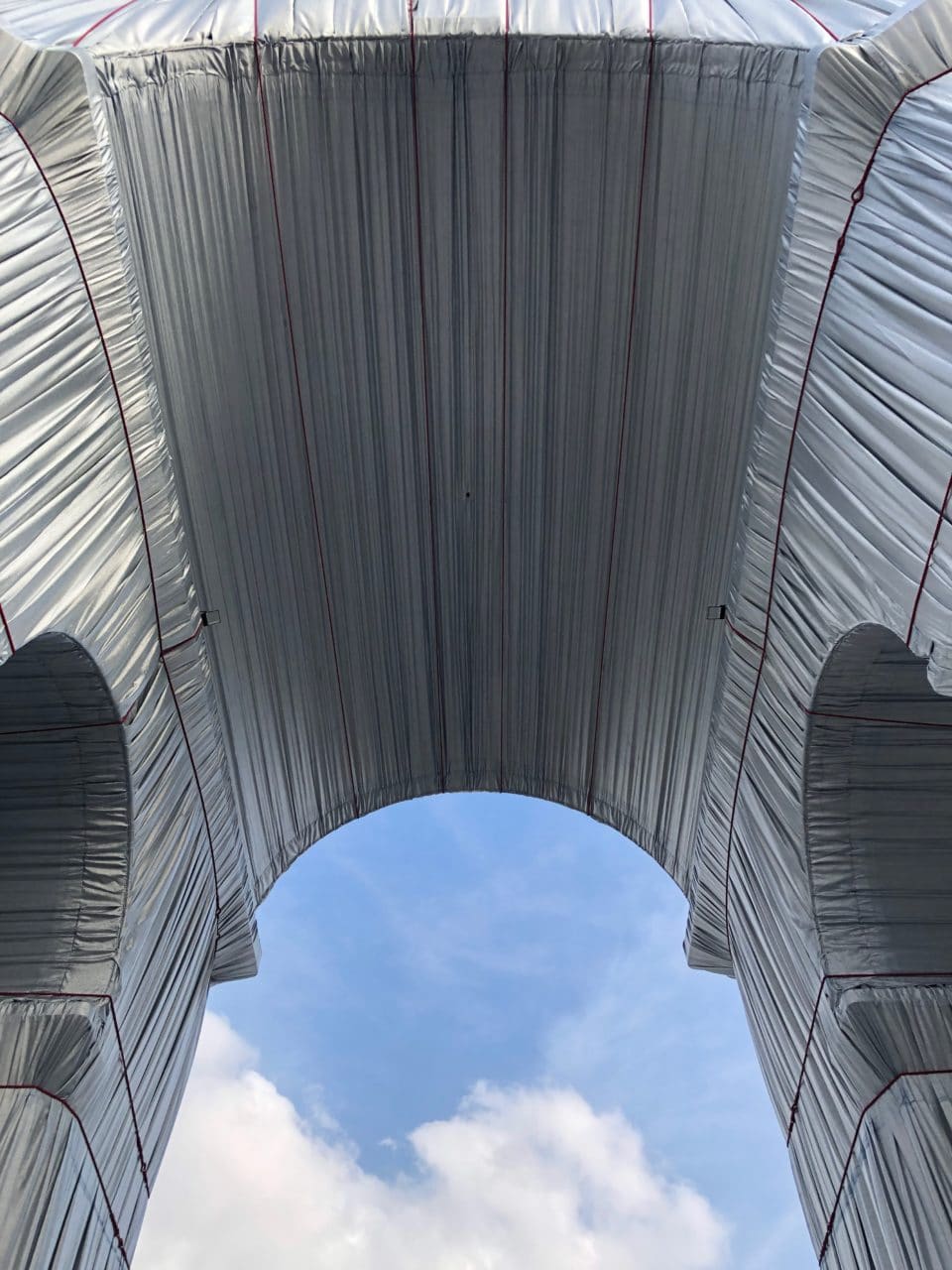Written by Sophie Bernal
It took thirty-six years for Paris to see one of its historic monuments wrapped by Christo and Jeanne-Claude. After the Pont-Neuf in 1985, it’s the Arc de Triomphe’s turn to be wrapped from head to toe. An ephemeral and spectacular work, L’Arc de Triomphe, Wrapped pays a final tribute to the two deceased artists (Jeanne-Claude passed away on November 18, 2009, Christo on May 31, 2020). Transformed for two weeks into a gigantic gift wrap, the monument is covered in 25,000m² of silver polypropylene held together by several thousand meters of red rope. As time erodes the fabric, its hues turn blue, revealing the three colors of the French flag, in a nod to the monument’s role as a symbol of national unity. The project was inaugurated on September 18, 2021 and will be visible until October 3, sixty years after its conception and after having undergone a postponement of one year due to the Covid-19 Pandemic.

It is thus in the particular context of a society crossed by various social, economic and political fractures, including the health crisis, that the work of the artist duo takes shape. By choosing the Arc de Triomphe, erected in 1836 in honor of Napoleon’s Imperial Army and which has since become a symbol of the Republic, Christo and Jeanne-Claude are perhaps demonstrating their desire to recompose national unity around common values: artistic creation given for free and visible to all. Eminently political, the Arc de Triomphe was also the site of the “Yellow Vest” protests in 2018. By reconciling contemporary creation and public authorities, the event can be read as an attempt to offer a new historical and artistic charge to the monument. It also seeks to shake up the sometimes rigid boundaries between historical heritage and contemporary creation, and to recreate social ties through the artistic experience.

This is precisely where the major challenge of the Arc de Triomphe, Wrapped, lies. By moving art into the public space, Christo and Jeanne-Claude redefine artistic spaces and propose an alternative to the classical modalities of access to works. Christo explained, in relation to the project The Umbrellas Japan-USA, (1984-91), that “the essence of [their] projects is the taking of possession of space”[1] If museums in 20th century Europe were the guarantors of the democratic ideals of their time, they were themselves the purveyors of normative models of taste and education. Since the phenomenon of the outdoor museum first appeared in the 1970s, the question of the visibility of works and their dissemination has been widely rethought. The advent of the art in situ also accelerated the artistic initiatives aiming to “de-elitize” art, to “de-sanctuarize” the museum. With Christo and Jeanne-Claude, the relationship of the work to the closed space of the museum is overturned. If they wrap it up, it is to reveal the architecture that hides under the fabric, inciting us to look at what we no longer see. One can nevertheless wonder: what is legitimate to impose on the sight of all in the public space? Is offering a greater access to art necessarily transgressive?


While art in the public space is sometimes seen as an instrument of resistance to the dominant institutions, here Christo and Jeanne-Claude do not disassociate themselves from the Institution, and even depend on it. Although the 14 million euros necessary for the realization of the project come exclusively from the Estate of Christo V. Javacheff, Christo’s nephew and director of the L’Arc de Triomphe, Wrapped, the project was presented to the Centre des monuments nationaux by the Centre Pompidou, which organized the exhibition Christo and Jeanne-Claude. Paris! in 2020, and is supported by the City of Paris. Day and night, mediators are on hand to answer visitors’ questions. Taschen, the artist couple’s historic publisher, has sent dozens of people to the exhibition to sell their works on the work of Christo and Jeanne-Claude. These are some of the clues that prevent us from seeing the event as an entirely transgressive and emancipatory act, but rather as a space of friction between art, marketing and public authorities. Finally, this is perhaps where the strength of L’Arc de Triomphe, Wrapped lies: a project that is less an aesthetic object than a collective ceremony.
[1] Christo quoted by Hugo Roux dans « Le Land art et les Christo : quand la création s’inscrit dans le terrain du quotidien et du pouvoir », France Culture, 18 September 2021.
Sophie Bernal is an independent curator and director of Collect.ives, based in Paris, France. Her writing has appeared in art publications, including Beaux Arts Magazine, The Steidz, and Point Contemporain.
